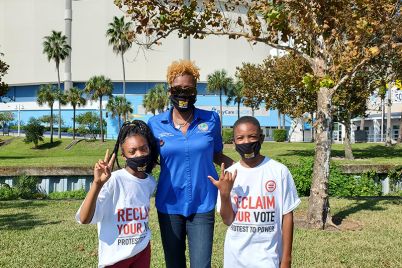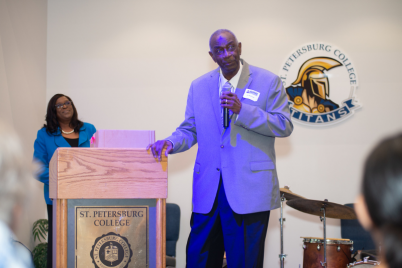‘A nursing shortage affects all of us. We recognize that it is imperative to the health and well-being of citizens throughout the state that we address the issue and come up with bold and sustainable solutions,’ SPC President Dr. Tonjua Williams said.
PINELLAS COUNTY — Florida faces a critical nursing shortage, and St. Petersburg College and its partners are taking a solutions-based approach to fix the problem.
A spring 2021 survey by the Florida Hospital Association found that one out of four registered nurses and one out of three critical care nurses had left their jobs in the previous year. They also found a 25 percent turnover rate, the highest over the past several years, and a projected deficit of 59,100 nurses in Florida by 2035, with 37,400 RNs and 21,700 licensed practical nurses.
To look at ways to address a burgeoning nursing shortage in Florida, St. Petersburg College gathered more than 50 regional stakeholders earlier this month. Leaders from area hospitals, nursing education institutions, nursing associations, and government officials met to try to assess problems that are contributing to the decline in the number of Florida’s nurses, as well as to brainstorm ideas for addressing those problems.
The Collaborative Problem-Solving Event: Taking Action to Address the Critical Nursing Shortage in Tampa Bay was hosted at SPC’s Collaborative Labs by St. Petersburg College, Pasco-Hernando State College, State College of Florida, and Hillsborough Community College.
“A nursing shortage affects all of us. We recognize that it is imperative to the health and well-being of citizens throughout the state that we address the issue and come up with bold and sustainable solutions,” SPC President Dr. Tonjua Williams said. “This meeting of the minds was a fantastic way to work directly with our partners to find ways to fill these crucial nursing positions in our community.”
Aggravating factors: an aging workforce, COVID-19 pandemic
This isn’t the first time that the nursing profession has faced a shortage, but certain factors exacerbate the situation. According to the U.S. Bureau of Labor Statistics, job growth for nurses in Florida is expected to grow by 21 percent, while at the same time, 40 percent of working nurses will approach retirement age in the next decade.
Also, the COVID-19 pandemic created stressful working conditions that brought about an increased turnover rate. According to Cheryl Love, chief clinical and patient safety officer, Florida Hospital Association, there is a definite problem, especially in Florida.
“In the middle of 2021, we asked hospitals to report vacancies and turnover,” Love said. “Overall, there was an 11 percent RN vacancy rate in Florida over 12 months, higher than the national rate of 9.9 percent.”
“We need to add more (nurses) than a couple thousand per year to mitigate the workforce shortage that is projected,” Love said.
Collaborative solutions needed
The group established priorities for employers and nursing education institutions. Employer issues included low salaries, making it hard to recruit good hires, hiring and retaining experienced nurses, and the desire to create a work environment that promotes job satisfaction and loyalty. Educational priorities include a faculty shortage due to low salaries and a need for recurring state funding to address that, and a lack of clinical site access.
The group broke out into teams to look at ways to address the priorities. Some of the top solutions were:
- Increase and allocate recurring funding from the state for educational technology and to raise faculty salaries
- Be creative in scheduling outside the 12-hour scheduling model for nurses, which would free experienced nurses to teach
- Create dedicated partnerships for clinical experiences
- Re-imagine clinicals to explore alternative experiences and add clinical capacity
- Create a healthy work environment assessment
- Increase National Council Licensure Examination (NCLEX) pass rates in Florida, which are over 17 percent lower than the national average
- Cultivate student engagement and look at student evaluation methods to ensure that they are rigorous, fair, and equitable
Higher education initiatives
Dr. Louisana Louis, dean of SPC’s College of Nursing, says the college is already actively working on some of these ideas. A gift last year from the Hough Family Foundation to SPC’s nursing program is allocated to enhance the college’s simulation area, where students get hands-on training with high-tech manikins, mirroring situations they would see in a live clinical experience.
“The Hough donation gives a bit more leverage,” Louis said. “It allows us to add three simulation rooms, so we can better prepare our nurses with the challenges they’ll meet at clinical sites.”
Louis said another focus is getting more nurses out into the community.
“We are creating a special cohort in the summer for students who were not successful in their last semester to give them another opportunity to graduate early,” Louis said. “And we are working on implementing an evening and weekend program within the next year, which will produce more nurses.”
Louis said the collaborative session was a great way to get state representatives, critical hospitals and agencies, and higher education representatives in one room to discuss the top barriers and issues and develop creative solutions.
“Before this session, everyone was having their solo discussions on how to address the nursing shortage,” she said. “This allowed us all to be in one room. It had not been done this way before, and that made all the difference.”









